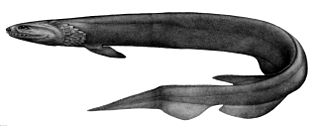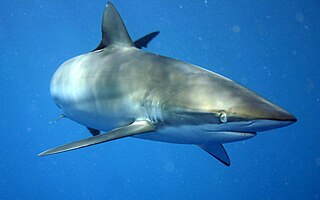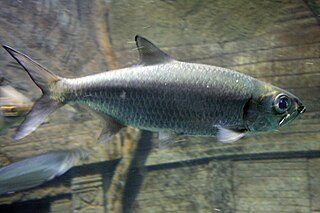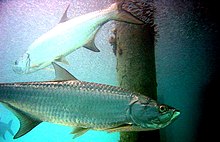
Brackish water, sometimes termed brack water, is water occurring in a natural environment that has more salinity than freshwater, but not as much as seawater. It may result from mixing seawater and fresh water together, as in estuaries, or it may occur in brackish fossil aquifers. The word comes from the Middle Dutch root brak. Certain human activities can produce brackish water, in particular civil engineering projects such as dikes and the flooding of coastal marshland to produce brackish water pools for freshwater prawn farming. Brackish water is also the primary waste product of the salinity gradient power process. Because brackish water is hostile to the growth of most terrestrial plant species, without appropriate management it is damaging to the environment.

The frilled shark, also known as the lizard shark, is one of the two extant species of shark in the family Chlamydoselachidae. The frilled shark is considered a living fossil, because of its primitive, anguilliform (eel-like) physical traits, such as a dark-brown color, amphistyly, and a 2.0 m (6.6 ft)–long body, which has dorsal, pelvic, and anal fins located towards the tail. The common name, frilled shark, derives from the fringed appearance of the six pairs of gill slits at the shark's throat.
Hemiramphidae is a family of fishes that are commonly called halfbeaks, spipe fish or spipefish. They are a geographically widespread and numerically abundant family of epipelagic fish inhabiting warm waters around the world. The halfbeaks are named for their distinctive jaws, in which the lower jaws are significantly longer than the upper jaws. The similar viviparous halfbeaks have often been included in this family.

The silky shark, also known by numerous names such as blackspot shark, gray whaler shark, olive shark, ridgeback shark, sickle shark, sickle-shaped shark and sickle silk shark, is a species of requiem shark, in the family Carcharhinidae, named for the smooth texture of its skin. It is one of the most abundant sharks in the pelagic zone, and can be found around the world in tropical waters. Highly mobile and migratory, this shark is most often found over the edge of the continental shelf down to 50 m (164 ft). The silky shark has a slender, streamlined body and typically grows to a length of 2.5 m. It can be distinguished from other large requiem sharks by its relatively small first dorsal fin with a curving rear margin, its tiny second dorsal fin with a long free rear tip, and its long, sickle-shaped pectoral fins. It is a deep, metallic bronze-gray above and white below.

An ocean current is a continuous, directed movement of seawater generated by a number of forces acting upon the water, including wind, the Coriolis effect, breaking waves, cabbeling, and temperature and salinity differences. Depth contours, shoreline configurations, and interactions with other currents influence a current's direction and strength. Ocean currents are primarily horizontal water movements.

The common snook is a species of marine fish in the family Centropomidae of the order Perciformes. The common snook is also known as the sergeant fish or robalo. It was originally assigned to the sciaenid genus Sciaena;Sciaena undecimradiatus and Centropomus undecimradiatus are obsolete synonyms for the species.

The white marlin, also known as Atlantic white marlin, marlin, skilligalee, is a species of billfish that lives in the epipelagic zone of the tropical and subtropical Atlantic Ocean. They are found between the latitudes of 45° N and 45° S in waters deeper than 100 m. Even though white marlin are found in bodies of water that are deeper than 100 m they tend to stay near the surface. White marlin have been found near banks, shoals, and canyons, but they are not limited to those locations. They prefer warm surface temperatures greater than 22 °C.

The ladyfish or tenpounder is a species of fish in the genus Elops, the only genus in the monotypic family Elopidae.
The tarpon is a species of a large, herring-like fish of the genus Megalops.

Pelagic fish live in the pelagic zone of ocean or lake waters—being neither close to the bottom nor near the shore—in contrast with demersal fish that live on or near the bottom, and reef fish that are associated with coral reefs.

The bigeye tuna is a species of true tuna of the genus Thunnus, belonging to the wider mackerel family Scombridae. In Hawaiian, it is one of two species known as ʻahi, the other being the yellowfin tuna. Bigeye tuna are found in the open waters of all tropical and temperate oceans, but not in the Mediterranean Sea.

Slickheads, also known as nakedheads or smoothheads, are deep water fishes that belong to the family Alepocephalidae. They are most commonly found in the bathypelagic layer, which is approximately 3000m below the surface. They get their name from the lack of scales on their heads. Similarly, the scientific name is from the Greek ᾰ̓- (a-, "not"); λέπος (lepos, "scale"); and κεφαλή (kephalē, "head"). It has about 22 genera with ca. 96 species.

The Pacific ladyfish, also known as the Pacific tenpounder and machete, is a species of ray-finned fish in the genus Elops, the only genus in the monotypic family Elopidae. The Pacific ladyfish can be found throughout the southwest U.S. and other areas in the Pacific Ocean.

The Atlantic tarpon is a ray-finned fish that inhabits coastal waters, estuaries, lagoons, and rivers. It is also known as the silver king. It is found in the Atlantic Ocean, typically in tropical and subtropical regions, though it has been reported as far north as Nova Scotia and the Atlantic coast of southern France, and as far south as Argentina. As with all elopiformes, it spawns at sea. Its diet includes small fish and crustaceans.

The Indo-Pacific tarpon, also known as the oxeye herring or simply herring due to its superficial resemblance to the true herrings, of which it is not a member, is the smaller of the two species of tarpon and lives in Indo-Pacific waters.

The Lessepsian migration is the migration of marine species along the Suez Canal, usually from the Red Sea to the Mediterranean Sea, and more rarely in the opposite direction. When the canal was completed in 1869, fish, crustaceans, mollusks, and other marine animals and plants were exposed to an artificial passage between the two naturally separate bodies of water, and cross-contamination was made possible between formerly isolated ecosystems. The phenomenon is still occurring today. It is named after Ferdinand de Lesseps, the French diplomat in charge of the canal's construction.

The Gobiiformes are an order of fish that includes the gobies and their relatives. The order, which was previously considered a suborder of Perciformes, is made up of about 2,211 species that are divided between seven families. Phylogenetic relationships of the Gobiiformes have been elucidated using molecular data. Gobiiforms are primarily small species that live in marine water, but roughly 10% of these species inhabit fresh water. This order is composed chiefly of benthic or burrowing species; like many other benthic fishes, most gobiiforms do not have a gas bladder or any other means of controlling their buoyancy in water, so they must spend most of their time on or near the bottom. Gobiiformes means "goby-like".
A warm core ring is a type of mesoscale eddy which forms and breaks off from an ocean current, such as the Gulf Stream or the Kuroshio Current. The ring is an independent circulatory system of warm water that can persist for several months before losing its distinctive identity. Warm core rings can be detected using infrared satellites or sea height anomalies resulting from and are easily identifiable against the surrounding colder waters. In addition, warm core rings are also distinguished by their low levels of biological activity. This type of system is thought to have helped develop several hurricanes, most notably Hurricane Katrina, into significantly stronger storms due to the abundance of warmer ocean water reaching down to a significant depth, which in turn fuels and intensifies the hurricane. Warm core rings are also known for affecting wildlife, having the capacity to bring wildlife from typically warm waters to areas typically dominated by cold waters.

The Atlantic needlefish is a common demersal needlefish species common in marinas and other areas with minimal currents. Its extremely long jaw and body set this fish apart from other predators. Atlantic needlefish are found from Maine to Brazil and have been known to venture into fresh water for short periods.

The Pacific spiny lumpsucker is a species of bony fish in the family Cyclopteridae.





















